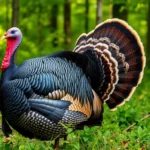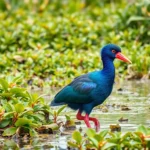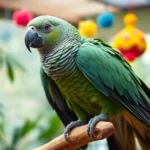We’ve all witnessed those breathtaking moments when a pristine white bird glides gracefully across a tranquil wetland, its elegant neck curved in perfect hunting position. That magnificent creature is likely an egret – one of nature’s most stunning and adaptable wading birds.
These remarkable birds have captured our imagination for centuries with their ethereal beauty and impressive hunting skills. From the towering Great Egret to the compact Snowy Egret, these feathered fishermen showcase incredible diversity across six continents. Whether you’re a seasoned birdwatcher or simply curious about wildlife, egrets offer fascinating insights into avian behavior and network health.
What makes these birds truly special isn’t just their striking appearance – it’s their incredible resilience and adaptability. We’ll explore how egrets have bounced back from near extinction, their unique feeding techniques, and why they’re considered essential indicators of environmental wellness in wetland ecosystems worldwide.
What Is an Egret Bird
Egrets are large wading birds that belong to the heron family Ardeidae, characterized by their distinctive long necks, sharp bills and elegant white plumage. These graceful waterbirds inhabit wetlands across six continents, with 13 recognized species distributed throughout North America, South America, Europe, Asia, Africa and Australia.
Physical characteristics distinguish egrets from other heron family members through their predominantly white feathers during breeding season, though some species like the Reddish Egret display colorful variations. Adult egrets range from 20 to 40 inches in height, with wingspans extending between 39 to 67 inches depending on the species. Great Egrets represent the largest variety, measuring up to 3.3 feet tall with impressive 67-inch wingspans.
Wetland ecosystems serve as primary habitats where egrets establish their feeding territories in marshes, swamps, ponds, lakes and coastal areas. Breeding colonies form in tall trees near water sources, with pairs constructing platform nests from sticks and vegetation 20 to 40 feet above ground level.
Dietary preferences focus on aquatic prey including fish, frogs, insects, crustaceans and small reptiles captured through precise striking motions. Hunting techniques involve patient stalking through shallow waters, with egrets using their razor sharp bills to spear prey items weighing between 0.5 to 8 ounces.
Conservation status varies among egret species, with Great Egrets recovering remarkably from near extinction in the early 1900s when plume hunting reduced populations to fewer than 1,000 breeding pairs. Current North American Great Egret populations exceed 200,000 individuals, demonstrating successful conservation efforts and habitat protection initiatives.
Behavioral patterns include seasonal migrations spanning thousands of miles for northern populations, while tropical species remain year round residents in their territories. Social structures during breeding season involve elaborate courtship displays featuring neck stretching, bill clattering and ornamental plume exhibitions.
Physical Characteristics of Egret Birds
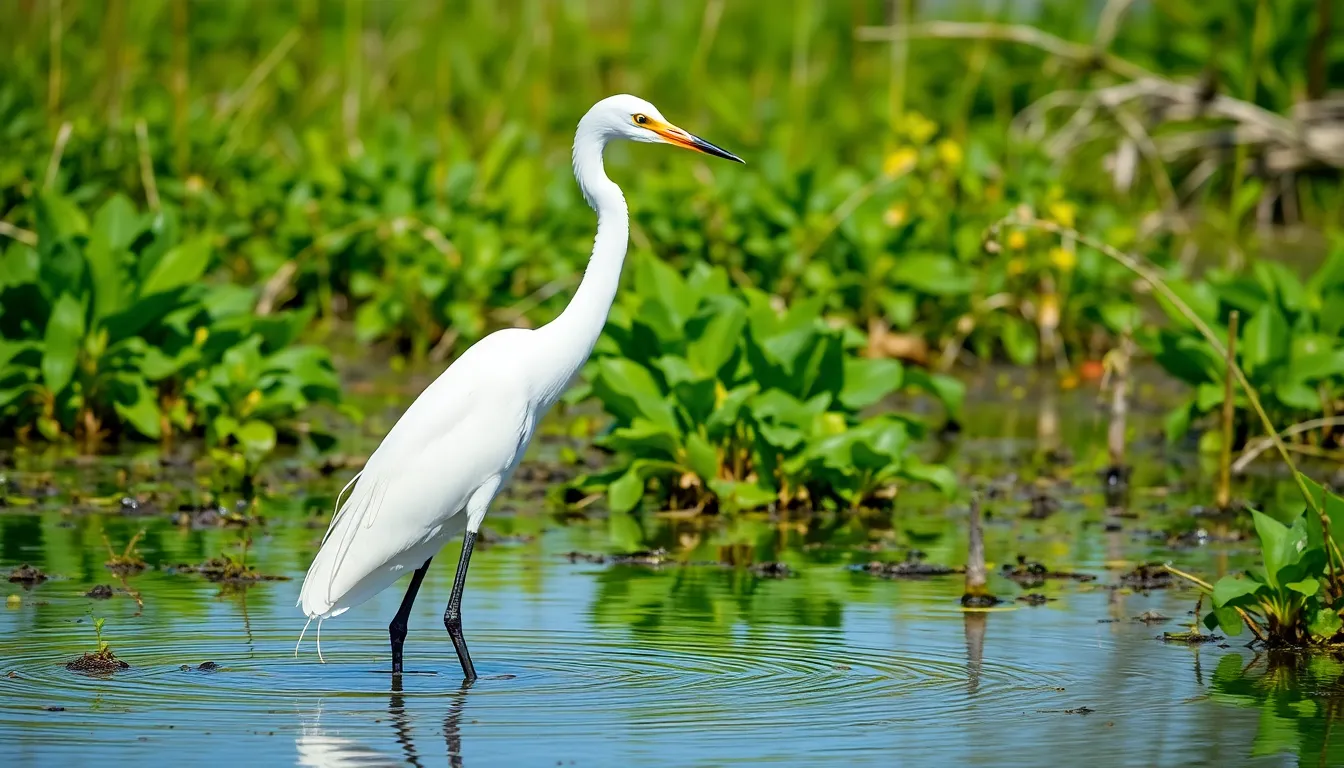
Egret birds display remarkable physical adaptations that make them highly effective hunters in aquatic environments. These elegant wading birds possess exact anatomical features that distinguish them from other members of the heron family.
Size and Build
Great Egrets stand as the largest species within the egret family, measuring 37-41 inches in height with wingspans reaching up to 67 inches. Cattle Egrets represent the smallest members at 19-21 inches tall, while Snowy Egrets maintain intermediate proportions at 22-26 inches in height.
| Species | Height (inches) | Wingspan (inches) | Weight (pounds) |
|---|---|---|---|
| Great Egret | 37-41 | 52-67 | 1.5-3.3 |
| Intermediate Egret | 22-28 | 41-45 | 0.7-1.8 |
| Snowy Egret | 22-26 | 39-45 | 0.8-1.2 |
| Cattle Egret | 19-21 | 35-38 | 0.6-1.1 |
Long necks create distinctive S-shaped curves that compress during striking motions, allowing rapid extension when capturing prey. Slender bodies reduce water resistance during wading movements through shallow wetlands. Extended legs position egrets at optimal heights for detecting fish and amphibians beneath water surfaces.
Distinctive Features and Plumage
Pure white feathers characterize most egret species during non-breeding seasons, providing excellent camouflage against bright sky backgrounds when viewed from below by potential prey. Sharp, pointed bills range from 3.5-6 inches in length depending on species, with yellow coloration typical during breeding periods.
Breeding plumage transforms egret appearances dramatically through ornate feather displays called aigrettes. Great Egrets develop flowing back plumes extending beyond tail feathers, while Snowy Egrets exhibit curved breast plumes and distinctive head crests. Black legs contrast sharply with white plumage in most species, though Snowy Egrets display bright yellow feet that become more vivid during courtship displays.
Facial skin changes color seasonally, shifting from yellow to bright green or blue during breeding periods. Eyes maintain bright yellow coloration year-round, providing excellent vision for detecting movement in murky water conditions. Flexible neck vertebrae allow 180-degree head rotation for comprehensive visual scanning of hunting territories.
Egret Bird Species Around the World
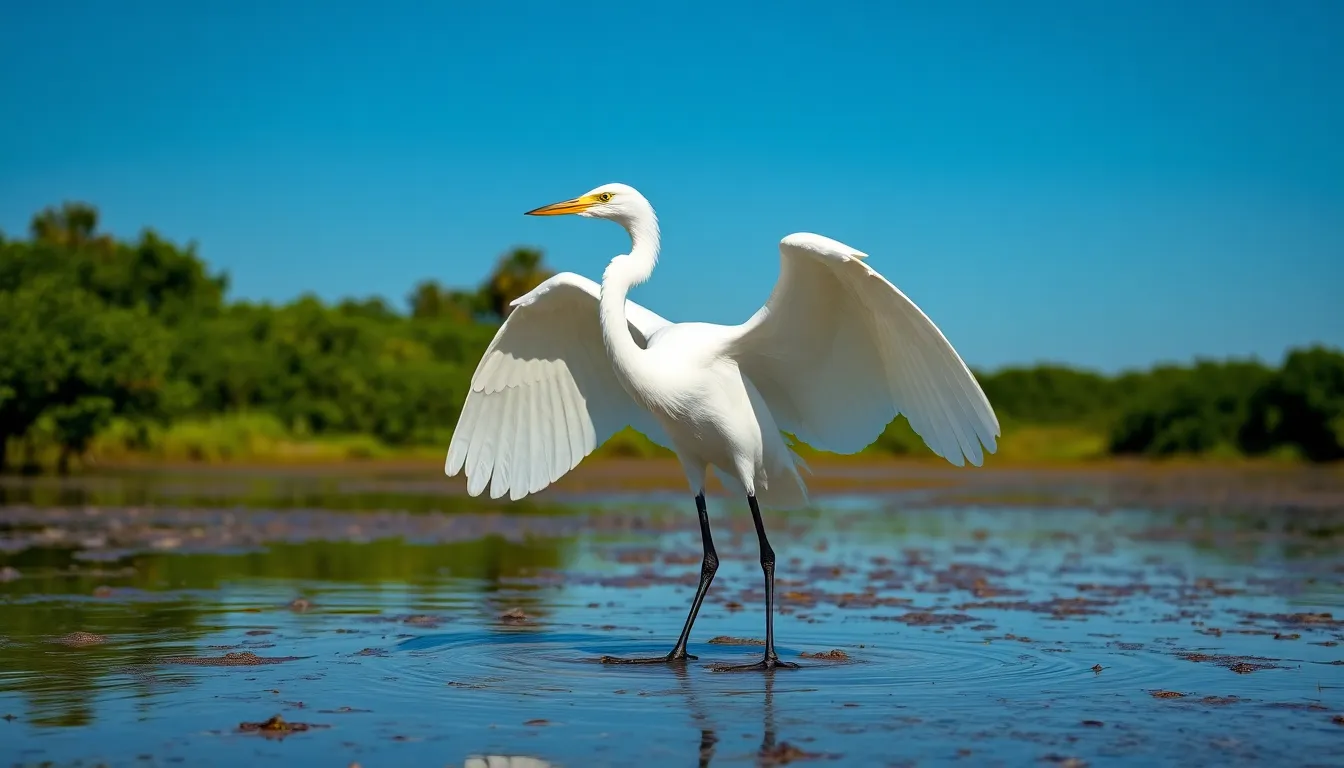
Egret species demonstrate remarkable diversity across global wetland ecosystems. We find these magnificent birds distributed across 13 distinct species that showcase unique adaptations and behaviors.
Great Egret
Great Egrets (Ardea alba) represent the largest members of the egret family, standing 37-41 inches tall with wingspans reaching 67 inches. We observe these impressive birds across all continents except Antarctica and Australia, making them the most widespread egret species globally. During breeding season, Great Egrets develop distinctive plume feathers called aigrettes that cascade elegantly from their backs.
Great Egrets inhabit freshwater marshes, coastal wetlands, and shallow lakes where they hunt fish, amphibians, and small mammals. We documented their remarkable recovery from near extinction in the early 1900s, when hunting for their decorative plumes nearly eliminated North American populations. Conservation efforts successfully restored their numbers, transforming them into symbols of wildlife protection success.
Snowy Egret
Snowy Egrets (Egretta thula) captivate observers with their pristine white plumage and distinctive yellow feet, earning them the nickname “golden slippers.” We measure these medium-sized egrets at 22-26 inches tall with 39-45 inch wingspans. Their sleek black bills and legs create striking visual contrast against their snow-white feathers.
Active hunters characterize Snowy Egret behavior, as we witness them stirring sediment with their bright yellow feet to flush prey. Snowy Egrets prefer coastal marshes, swamps, and shallow ponds throughout North and South America. We observe their elaborate courtship displays during breeding season, featuring raised neck plumes and intricate dancing movements that strengthen pair bonds.
Cattle Egret
Cattle Egrets (Bubulcus ibis) distinguish themselves as the smallest egret species at 19-21 inches tall and demonstrate unique terrestrial feeding habits. We trace their remarkable global expansion from Africa across six continents within the past century, making them one of the industry’s most successful colonizing bird species. These adaptable egrets developed symbiotic relationships with grazing mammals, following cattle and other livestock to capture insects disturbed by their movement.
During non-breeding periods, Cattle Egrets maintain pure white plumage, but we observe dramatic transformations during breeding season when their heads, backs, and chests develop rich buff-orange coloring. Cattle Egrets thrive in grasslands, agricultural areas, and pastures where we frequently spot them perched on the backs of cattle, horses, and other large mammals while hunting for insects and small vertebrates.
Natural Habitat and Distribution
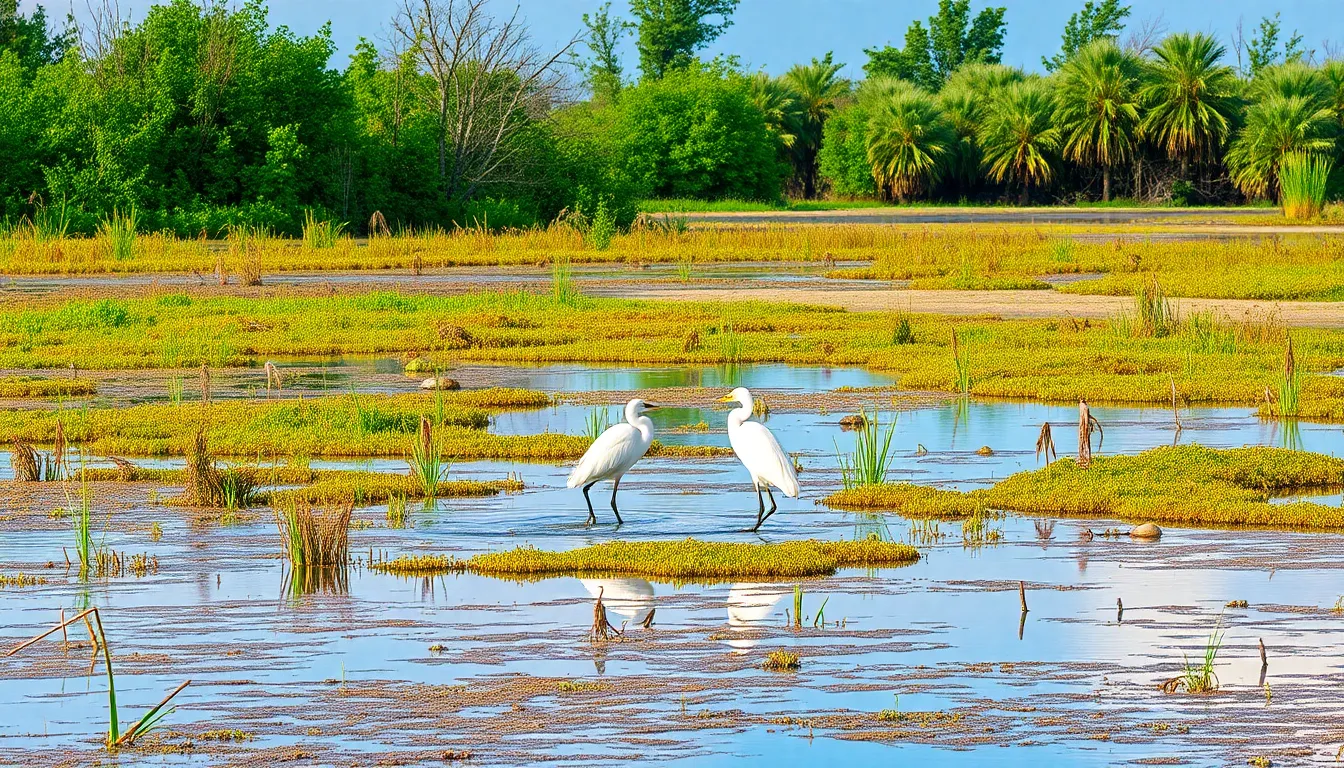
Egret birds inhabit diverse wetland ecosystems across six continents, demonstrating remarkable adaptability to various aquatic environments. Freshwater marshes, coastal estuaries, and shallow lakes provide the primary hunting grounds for these elegant wading birds. Saltwater environments including tidal flats, mangrove swamps, and lagoons support many egret populations throughout their global range.
Great Egrets maintain the most extensive distribution among all egret species, spanning North America, South America, Europe, Asia, Africa, and Australia. These adaptable birds occupy habitats from sea level to elevations reaching 4,900 feet in mountainous regions. Breeding colonies typically establish near protected water sources with abundant fish populations and suitable nesting vegetation.
Snowy Egrets concentrate their populations along coastal regions and inland wetlands across North and South America. Migration patterns for this species extend from southern Canada to Argentina, with wintering grounds in Central and South America. Preferred habitats include shallow ponds, rice fields, and protected marshlands with water depths ranging from 6 to 24 inches.
Cattle Egrets exhibit the most remarkable distribution expansion of any egret species, originally native to Africa but now established on every continent except Antarctica. These birds colonized the Americas during the 1950s and reached Australia by the 1960s through natural dispersal. Agricultural landscapes, pastures, and grasslands provide primary foraging habitats alongside traditional wetland environments.
| Species | Geographic Range | Preferred Depth (inches) | Primary Habitat Type |
|---|---|---|---|
| Great Egret | 6 continents | 12-36 | Freshwater marshes |
| Snowy Egret | Americas | 6-24 | Coastal wetlands |
| Cattle Egret | Global (except Antarctica) | 0-12 | Agricultural areas |
| Little Egret | Europe, Asia, Africa | 3-18 | Shallow ponds |
Seasonal migrations significantly influence egret distribution patterns across their ranges. Northern populations migrate southward during winter months, traveling distances exceeding 3,000 miles to reach suitable wintering grounds. Breeding habitats require exact conditions including water temperatures between 60-75°F and prey density of at least 50 fish per square meter.
Urbanization and habitat modification continue to reshape egret distribution patterns globally. These adaptable birds increasingly use constructed wetlands, retention ponds, and golf course water features as alternative habitats. Climate change affects traditional migration routes, with some populations shifting their ranges northward by approximately 35 miles per decade.
Feeding Behavior and Diet

Egrets demonstrate exceptional hunting prowess through their specialized feeding behaviors that we observe across wetland environments. These skilled predators employ multiple hunting techniques, ranging from patient stalking to active pursuit methods that maximize their success rates in capturing aquatic prey.
Primary feeding strategies include the stand-and-wait technique, where egrets remain motionless for extended periods before striking with lightning-fast precision. Active hunting methods involve walking slowly through shallow waters while continuously scanning for movement below the surface. Disturb-and-chase behaviors allow egrets to flush prey from hiding spots by using their feet to stir sediment and vegetation.
Primary Prey Species
Fish constitute the dominant component of egret diets, with species preferences varying by habitat and geographic location:
| Prey Category | Examples | Percentage of Diet |
|---|---|---|
| Fish | Minnows, killifish, sunfish, bass | 60-80% |
| Amphibians | Frogs, tadpoles, salamanders | 10-20% |
| Aquatic Invertebrates | Crayfish, shrimp, water beetles | 5-15% |
| Small Reptiles | Water snakes, lizards | 3-8% |
| Insects | Dragonflies, water bugs, grasshoppers | 2-5% |
Seasonal availability significantly influences prey selection, with egrets adapting their hunting focus based on breeding cycles of local aquatic species. Winter months typically see increased consumption of fish, while spring and summer diets incorporate more amphibians and invertebrates.
Hunting Techniques and Adaptations
Striking mechanics involve rapid neck extension that occurs in less than 0.1 seconds, allowing egrets to capture fast-moving prey before escape becomes possible. We observe that their specialized neck vertebrae create an S-shaped curve that stores kinetic energy like a compressed spring during the strike sequence.
Visual hunting adaptations include binocular vision that provides precise depth perception for accurate strikes in water environments. Specialized eye positioning allows egrets to compensate for light refraction at the water surface, ensuring accurate targeting of submerged prey.
Feeding flexibility enables egrets to adjust their techniques based on water depth and prey behavior. Shallow water hunting involves direct visual tracking, while deeper water requires tactile sensing through bill contact. Group feeding behaviors occur when prey concentrations create opportunities for multiple individuals to hunt simultaneously without territorial conflicts.
Cattle Egrets exhibit unique foraging behaviors by following livestock and agricultural machinery to capture insects disturbed from grass and soil. This commensal relationship provides consistent food sources while requiring minimal energy expenditure for prey location.
Breeding and Nesting Patterns
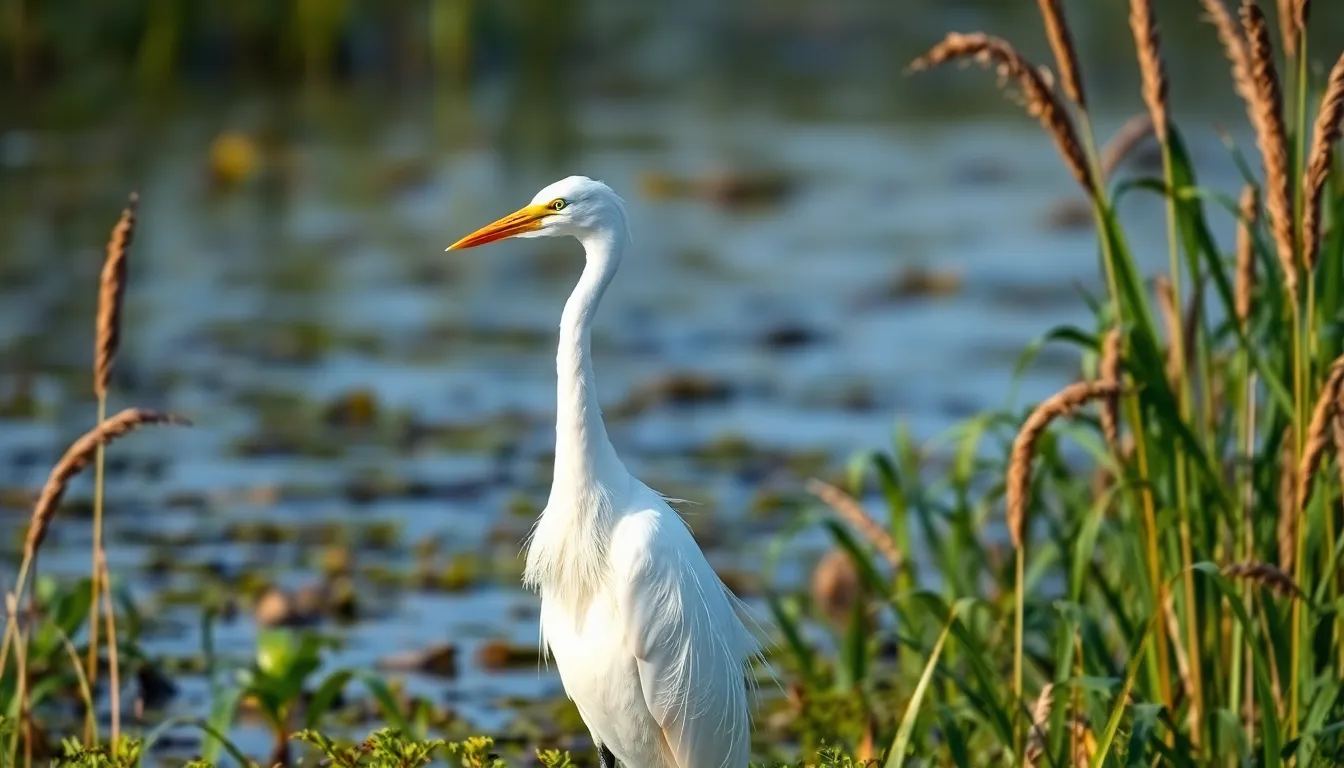
Breeding cycles among egrets typically begin between March and July, with timing varying significantly across species and geographic regions. Great Egrets establish their breeding territories 2-4 weeks before females arrive, with males performing elaborate courtship displays that include neck stretching and ritualized feeding demonstrations. Colonial nesting characterizes most egret species, with colonies ranging from 12-15 pairs in smaller groups to over 1,000 pairs in major rookeries.
Nest construction involves both male and female egrets, though males gather approximately 75% of the nesting materials. Platform nests measure 12-20 inches in diameter and consist of interwoven sticks, reeds, and aquatic vegetation positioned 10-40 feet above water level. Trees like willows, cypress, and mangroves serve as primary nesting sites, while ground nesting occurs in areas lacking suitable vegetation.
| Species | Clutch Size | Incubation Period | Nestling Period |
|---|---|---|---|
| Great Egret | 3-5 eggs | 23-26 days | 42-49 days |
| Snowy Egret | 3-4 eggs | 20-24 days | 35-42 days |
| Cattle Egret | 2-6 eggs | 22-26 days | 30-35 days |
Egg laying occurs at 2-day intervals, with pale blue-green eggs measuring approximately 2.3 inches in length. Both parents share incubation duties equally, switching positions every 4-6 hours throughout the day. Temperature regulation remains critical during this period, as eggs require consistent temperatures between 97-99°F for successful development.
Parental care extends 6-8 weeks beyond hatching, with adults providing regurgitated food directly into nestlings’ mouths. Feeding frequency peaks at 8-12 times daily during the first two weeks, gradually decreasing as chicks develop. Fledgling egrets remain dependent on parental feeding for an additional 2-3 weeks after leaving the nest.
Territorial behavior intensifies during breeding season, with males defending areas spanning 15-30 feet around active nests. Aggressive displays include bill pointing, crest raising, and harsh vocalizations directed at intruders. Success rates for egret breeding colonies typically range from 65-85%, with weather conditions and food availability serving as primary determining factors.
Mixed species rookeries commonly occur, with egrets nesting alongside herons, ibises, and cormorants. These multi species colonies provide enhanced protection through increased vigilance and shared alarm systems. Site fidelity remains strong among successful breeding pairs, with 70-80% returning to previous nesting locations in subsequent years.
Egret Bird Behavior and Social Structure
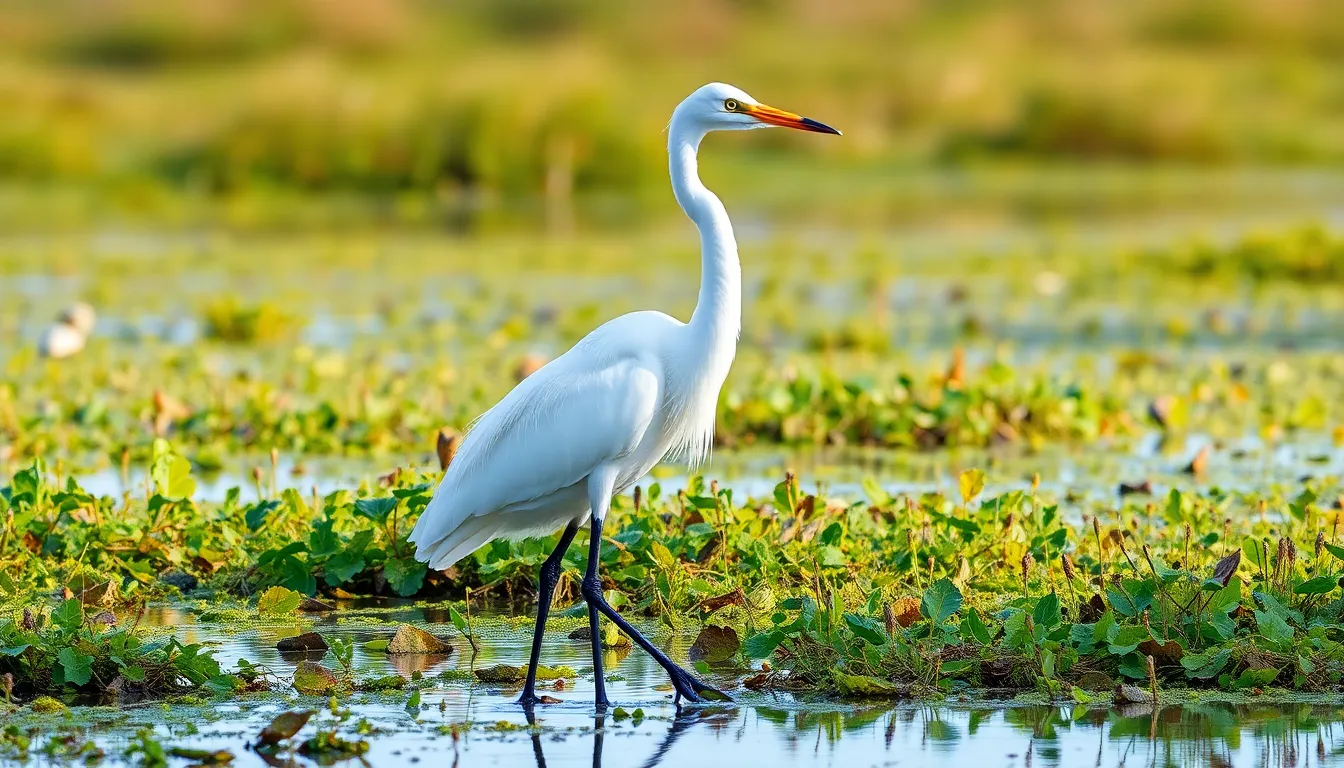
Egret birds exhibit complex social behaviors that vary significantly between breeding and non-breeding seasons. During feeding periods, most egret species demonstrate territorial behavior around prime hunting locations, defending areas spanning 50-100 square meters from competing birds. Great Egrets display the most aggressive territorial tendencies, often captivating in elaborate threat displays that include neck stretching, bill pointing, and wing spreading to establish dominance over feeding territories.
Colonial nesting represents the most prominent social behavior among egret populations. Rookeries contain anywhere from 20 to over 1,000 breeding pairs, with Great Egret colonies averaging 150-200 nests per site. These communal breeding grounds provide enhanced protection against predators through collective vigilance and shared alarm calls that alert the entire colony to potential threats.
Social hierarchies emerge within egret colonies based on factors including age, size, and breeding experience. Dominant males secure the most desirable nesting sites positioned at optimal heights of 15-25 feet above water, while subordinate individuals occupy peripheral locations with reduced protection and visibility. Established breeding pairs return to the same colonial sites annually, maintaining social bonds and territorial positions from previous seasons.
Communication patterns among egrets involve a sophisticated system of vocalizations and visual displays. Adults produce 8-12 distinct calls ranging from harsh croaks during territorial disputes to soft grunts during pair bonding activities. Breeding males perform intricate courtship rituals featuring synchronized head movements, ceremonial stick presentations, and aerial displays that demonstrate their fitness to potential mates.
Foraging behavior reveals varying degrees of social tolerance among egret species. Cattle Egrets demonstrate the highest social cooperation, frequently feeding in mixed flocks of 20-50 individuals while following livestock herds. Snowy Egrets exhibit moderate social feeding, occasionally gathering in groups of 5-15 birds during peak prey abundance. Great Egrets typically maintain solitary feeding patterns except during extraordinary food concentrations.
Seasonal behavioral shifts influence egret social structures throughout their annual cycles. Non-breeding aggregations form at communal roosts where hundreds of individuals gather each evening, sharing information about productive feeding locations through subtle behavioral cues. Winter flocks display reduced aggression compared to breeding season interactions, allowing closer proximity between individuals during roosting and feeding activities.
Juvenile egrets remain with their parents for 6-8 weeks post-fledging, learning essential hunting techniques and social behaviors through observation and practice. Young birds gradually integrate into adult social structures, initially occupying subordinate positions within feeding hierarchies before establishing their own territories during subsequent breeding seasons.
Human-adapted egret populations demonstrate modified social behaviors in urban environments. City-dwelling egrets exhibit increased tolerance for human proximity and reduced flight distances compared to their wetland counterparts. Urban colonies often form smaller groups of 10-30 pairs due to limited suitable nesting sites, resulting in intensified territorial competition within these concentrated breeding areas.
Conservation Status and Threats
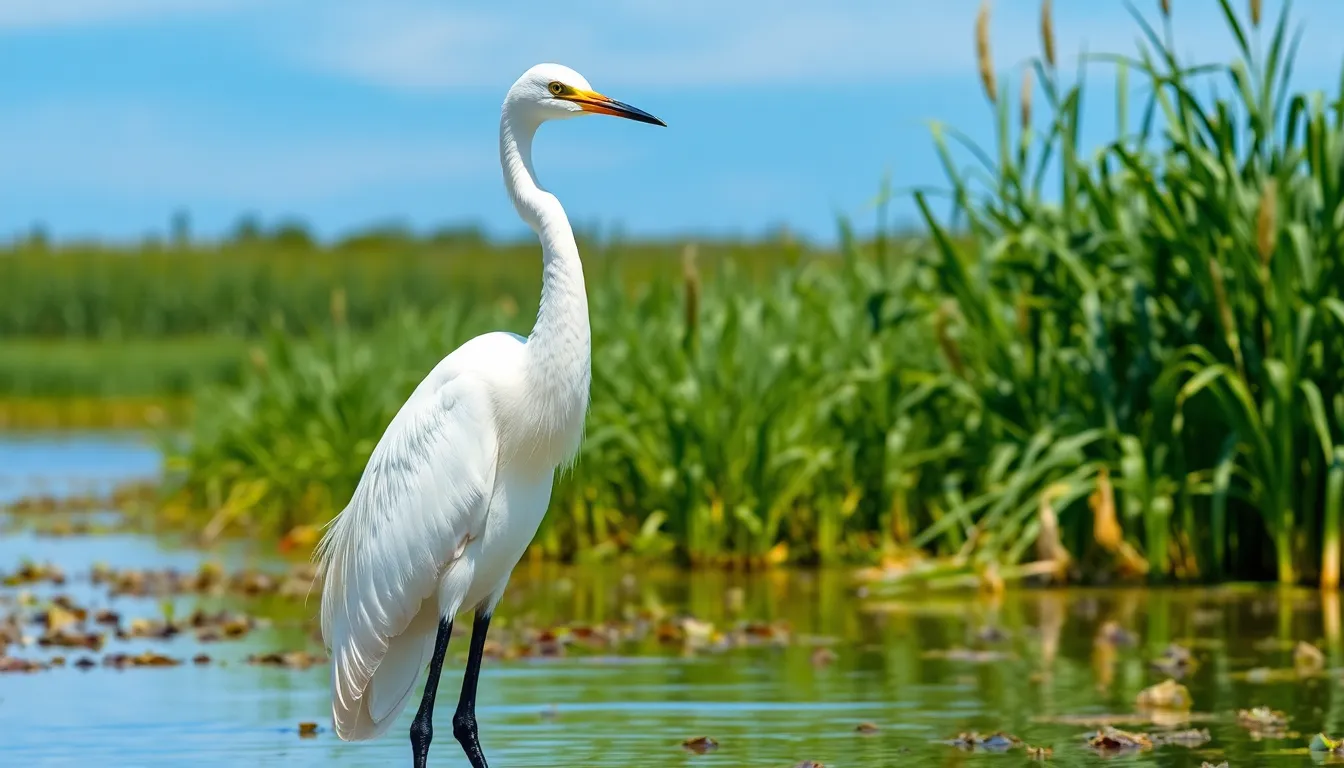
Conservation status among egret species varies significantly, with the Great Egret representing one of conservation’s greatest success stories after recovering from near extinction in the early 1900s. The International Union for Conservation of Nature (IUCN) currently lists most egret species as “Least Concern,” though regional populations face varying degrees of threat.
Great Egrets experienced severe population declines during the late 19th and early 20th centuries when commercial hunting for their ornate breeding plumes nearly drove them to extinction across North America. Feather hunters targeted breeding colonies extensively, reducing populations by an estimated 95% between 1880 and 1910. The Migratory Bird Treaty Act of 1918 and subsequent conservation efforts enabled remarkable population recovery, with current North American populations exceeding pre-exploitation levels.
| Species | IUCN Status | Population Trend | Primary Threats |
|---|---|---|---|
| Great Egret | Least Concern | Stable/Increasing | Habitat loss, climate change |
| Snowy Egret | Least Concern | Stable | Coastal development, pollution |
| Cattle Egret | Least Concern | Increasing | Pesticide use, agricultural changes |
| Little Egret | Least Concern | Stable | Wetland drainage, disturbance |
Habitat destruction poses the most important contemporary threat to egret populations across all species. Wetland loss accounts for approximately 50% of original wetland habitat in North America since European settlement, directly impacting egret feeding and nesting areas. Coastal development particularly affects Snowy Egrets, which rely heavily on estuarine environments for breeding and foraging.
Climate change creates emerging challenges for egret conservation through altered precipitation patterns and rising sea levels. Shifting weather patterns affect wetland water levels, influencing prey availability and breeding success rates. Rising temperatures also modify migration timing and breeding schedules, potentially disrupting synchronized life cycle events.
Water pollution significantly threatens egret health through bioaccumulation of toxins in aquatic food webs. Heavy metals like mercury concentrate in fish tissues, which egrets consume in large quantities. Pesticide runoff from agricultural areas creates additional contamination risks, particularly affecting Cattle Egrets that forage in treated farmland.
Human disturbance at nesting colonies reduces breeding success rates when visitors or construction activities cause colony abandonment. Colonial nesting species are especially vulnerable since entire populations may relocate when disturbed during critical breeding periods. Buffer zones around known rookeries help minimize these impacts.
Invasive species introduction alters egret habitat quality by changing prey communities and vegetation structure. Purple loosestrife and other invasive plants modify wetland ecosystems, reducing native fish and invertebrate populations that egrets depend upon for food.
Power line collisions cause important mortality among egrets during migration and daily movements between roosting and feeding sites. Large wingspan and flight patterns make egrets particularly susceptible to striking overhead wires, especially during low visibility conditions.
Conservation success depends on continued habitat protection and restoration efforts targeting wetland ecosystems. The North American Bird Conservation Initiative identifies egrets as priority species for wetland conservation programs. Constructed treatment wetlands provide additional habitat while serving water management functions, demonstrating how conservation can align with human infrastructure needs.
Monitoring programs track population trends and breeding success across egret species to identify emerging threats and measure conservation effectiveness. Annual Christmas Bird Counts and Breeding Bird Surveys provide long term population data essential for adaptive management strategies.
How to Spot Egret Birds in the Wild

Spotting egrets in their natural habitat requires understanding their preferred environments and recognizing their distinctive characteristics. We can maximize our chances of egret encounters by targeting exact locations and learning key identification markers.
Best Locations for Egret Watching
Freshwater marshes provide prime egret watching opportunities, particularly during early morning hours from 6:00-9:00 AM when feeding activity peaks. Shallow lakes with water depths of 6-24 inches attract Great Egrets and Snowy Egrets throughout spring and summer months.
Coastal estuaries offer year-round egret viewing, with Snowy Egrets concentrating along tidal flats during low tide periods. Constructed wetlands near urban areas increasingly support egret populations, making these accessible locations excellent for beginners.
Cattle ranches and agricultural fields present unique opportunities to observe Cattle Egrets following livestock during daylight hours. Mixed-species rookeries in tall trees near water sources become active viewing locations during breeding season from March through July.
| Location Type | Best Viewing Times | Primary Species | Peak Seasons |
|---|---|---|---|
| Freshwater Marshes | 6:00-9:00 AM | Great, Snowy Egrets | Spring-Summer |
| Coastal Estuaries | Low Tide Periods | Snowy Egrets | Year-round |
| Cattle Ranches | Daylight Hours | Cattle Egrets | Year-round |
| Mixed Rookeries | March-July | All Species | Breeding Season |
Identification Tips
Great Egrets stand 37-41 inches tall with black legs and yellow bills, making them the largest and most recognizable species. Snowy Egrets display bright yellow feet contrasting with black legs and bills, earning them the nickname “golden slippers.”
Cattle Egrets measure 19-21 inches in height with shorter necks and stockier builds compared to other egret species. During breeding season, these birds develop buff-orange plumes on their heads, backs, and breasts.
Flight patterns distinguish egrets from similar wading birds, as they retract their necks into an S-curve while flying with slow, steady wingbeats. Feeding behavior provides reliable identification markers, with Great Egrets using patient stand-and-wait techniques while Snowy Egrets employ more active pursuit strategies.
Seasonal plumage changes affect identification accuracy, particularly during breeding when egrets develop ornate feather displays and facial skin color variations. Juvenile egrets present identification challenges with mottled plumage patterns that differ significantly from adult coloration until their first molt.
Conclusion
These remarkable wading birds continue to captivate us with their grace and resilience. We’ve witnessed their incredible journey from near extinction to thriving populations across diverse ecosystems worldwide.
Understanding egrets deepens our appreciation for wetland conservation and the delicate balance of aquatic environments. Their presence serves as a powerful indicator of network health and reminds us of our responsibility as stewards of these critical habitats.
Whether you’re an experienced birder or just beginning to explore avian wildlife we encourage you to seek out these elegant creatures in their natural settings. Each encounter offers a unique opportunity to witness the beauty and complexity of nature’s most sophisticated hunters.
The story of egrets is eventually one of hope – proof that dedicated conservation efforts can restore wildlife populations and preserve biodiversity for future generations.
Frequently Asked Questions
What are egrets and how are they related to herons?
Egrets are large wading birds belonging to the heron family Ardeidae. They are characterized by their elegant white plumage, long necks, and sharp bills. With 13 recognized species distributed across six continents, egrets are essentially a specialized group within the heron family, adapted for hunting in wetland environments.
How big do egrets get and what are the size differences between species?
Egret sizes vary significantly by species. Great Egrets are the largest, reaching heights of 37-41 inches, making them impressive wading birds. At the other end of the spectrum, Cattle Egrets are the smallest species at just 19-21 inches tall. These size differences reflect their diverse ecological niches and hunting strategies.
What do egrets eat and how do they hunt?
Egrets primarily feed on fish, which comprises 60-80% of their diet, along with frogs, aquatic invertebrates, small reptiles, and insects. They employ specialized hunting techniques including stand-and-wait tactics, active pursuit, and disturb-and-chase behaviors. Their patient stalking in shallow waters and precise striking motions make them highly effective predators.
Where can I find egrets in the wild?
Egrets inhabit diverse wetland ecosystems including freshwater marshes, coastal estuaries, shallow lakes, and agricultural fields. Great Egrets have the most extensive global distribution, while Snowy Egrets concentrate along coastal regions. The best viewing locations are wetlands during early morning or late afternoon when they’re most active.
Are egrets endangered or threatened?
Most egret species are currently listed as “Least Concern” by the IUCN. Great Egrets made a remarkable recovery from near extinction in the early 1900s thanks to successful conservation efforts. However, habitat destruction, climate change, water pollution, and human disturbance continue to pose ongoing threats to their populations.
When and how do egrets breed?
Egret breeding season typically occurs between March and July, varying by species and region. They nest colonially for protection, with males constructing nests using sticks and reeds positioned high above water. Both parents share incubation duties and feeding responsibilities, with elaborate courtship displays preceding pair bonding.
How can I identify different egret species?
Great Egrets are the largest with yellow bills and black legs. Snowy Egrets are medium-sized with black bills, black legs, and distinctive yellow feet. Cattle Egrets are the smallest with yellow bills and legs. During breeding season, all species develop ornate plumage and distinctive color changes in facial skin.
Do egrets migrate and how does this affect their distribution?
Yes, many egret populations migrate seasonally, with northern populations traveling southward during winter. These migrations significantly influence their distribution patterns. Climate change is causing shifts in traditional migration routes, and egrets are adapting by utilizing both natural and constructed wetlands along their journey.
What role do egrets play in their ecosystems?
Egrets serve as important indicators of environmental health in wetland ecosystems. As skilled predators, they help control fish and invertebrate populations. Their presence often indicates healthy wetland conditions, while their colonial nesting behavior contributes to the biodiversity and ecological balance of their habitats.
How do egrets behave socially?
Egrets exhibit complex social behaviors that change seasonally. During breeding, they form colonies for protection and establish social hierarchies. Outside breeding season, they may feed territorially but often roost communally. They communicate through various vocalizations and visual displays, with juveniles learning essential survival skills from their parents.








